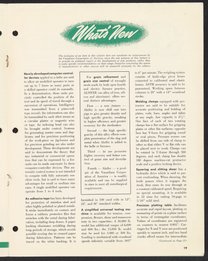The Vancoram Review
- 1949-Dec

Rights
Download all 12 images
PDFZIPof full-sized JPGsDownload selected image
Small JPG1200 x 1520px — 437 KBLarge JPG2880 x 3647px — 3.7 MBFull-sized JPG3604 x 4564px — 5.6 MBOriginal fileTIFF — 3604 x 4564px — 47.1 MBNewsletter issued by the Vanadium Corporation of America with articles entitled "Uranium in the Colorado Plateau Area," "Bus Springs: Wellsprings of Good Will," "The Vanadium Minerals — Part II — Mineral Sources of Vanadium," "Vanadium Data Sheet — Optical and Other Physical Properties," "Sixteen-Year Record in Hammermill Service Proves Reliability of Vanadium Steel Shafts, "What's New," "Abstracts of Current Literature," and "Vancorum Products — Compositions — Applications." Newsletter features black and white photographs of a Uranium mill and plant, a Navajo Indian mining crew, and a map showing the Vanadium Corporation of America's Uranium plants and mines in Colorado, New Mexico, Utah and Arizona.
Vanadium, a malleable transition metal, was discovered in its natural state in Mexico by Spanish-Mexican scientist, engineer, and naturalist Andrés Manuel del Río (1764-1849) in 1801, though it was not isolated and recognized as an element until 1830. Following the discovery of a large deposit of vanadium in the Peruvian Andes in 1905, vanadium became commercially viable and significantly impacted the steel industry. In 1906, the American Vanadium Company (later the Vanadium Corporation of America) was organized to mine the new deposit, known as Mina Ragra, and use of vanadium to produce specialty steel alloys quickly became widespread, particularly in the burgeoning automobile industry.
| Property | Value |
|---|---|
| Place of publication | |
| Format | |
| Genre | |
| Extent |
|
| Language | |
| Subject | |
| Rights | Public Domain Mark 1.0 |
| Credit line |
|
Institutional location
| Department | |
|---|---|
| Collection | |
| Physical container |
|
View collection guide View in library catalog
Related Items
Cite as
“The Vancoram Review.” New York, New York, December 1949. Vanadium Corporation of America Photograph Collection, Box 1. Science History Institute. Philadelphia. https://digital.sciencehistory.org/works/k0698835k.
This citation is automatically generated and may contain errors.
Rights
Download all 12 images
Searchable PDFmay contain errorsZIPof full-sized JPGsDownload selected image
-
Keyboard Shortcuts
Previous image shift + or , Next image shift + or . Pan image Zoom in + or shift + Zoom out - or shift + Zoom to fit 0 Close viewer esc Also
Mouse click to zoom in; shift-click to zoom out. Drag to pan. Pinch to zoom on touch.
















